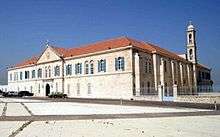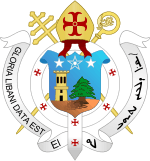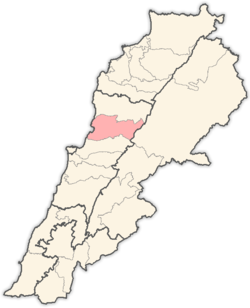Bkerké
Bkerké (Arabic: بكركي, also Bkerke or Bkirki) is the episcopal see of the Maronite Catholic Patriarchate of Antioch of the Maronite Church in Lebanon, located 650 m above the bay of Jounieh, northeast of Beirut, in Lebanon.

| Part of a series on |
| Maronite Church |
|---|
 |
| Patriarchate |
| Religious orders and societies |
| Communities |
|
| Languages |
| History |
| Related politics |
|
|
Though now exclusively used by the church, the area was owned by the noble Khazen family. The clergy use it under a special waqf.[1][2]
History
The earliest building on the Bkerké site was a monastery constructed in 1703 by Khattar al-Khazen. In 1730, Antonine monks began using the monastery. In 1750, Bishop Germanus Saqar and the nun Hindiyya al-'Ujaimi used it for the Sacred Heart of Jesus religious order. Finally, in 1779, it came into use by the Maronite church, and in 1830 it became the winter residence of the Lebanon's Maronite Patriarch. The present red roofed structure was built in 1893[3] during the time of Patriarch John Peter El Hajj. It was designed by Leonard al-Azari.
Since its creation around 858 AD, the see of the Maronite Catholic Patriarchate has never been in Antioch. Instead, it was originally in Kfarhay in the Batroun mountains, and then continued to move to various locations in the Byblos mountains for the next 500 years, such as Yanouh, Mayfouq, Lehfed, Habeel, Kfifan, al-Kafr, and Hardeen. It then moved to Qannoubine in the Kadisha Valley because of intensified persecution and remained there from 1440 to 1823 when it moved to Dimane and lastly, in 1830, to Bkerké.[4] Today, Maronite Patriarchs use Dimane as a summer residence and Bkerké as a winter one.
The monastery was renovated in 1970 by Patriarch Paul Peter Meouchi. Patriarch Anthony Peter Khoraish added the external gate in 1982, and in 1995 Patriarch Nasrallah Boutros Sfeir built a new wing to house the archives and serve as a museum. He also established tombs for the patriarchs and decorated the church with ornate windows.[5]
An old book references a convent, called Kourket, that was likely in this same area, if not on the same site. According to these (likely sensationalized) stories, the convent, founded around 1755, had high death rates, blamed on the air of the region. In 1775, a traveler, who spent the night outside the convent walls, observes a body being secretively buried and tells the local ruler. He sends a contingent of horsemen to gain access to the convent, where they discover "abominations which make the hair stand on end". The founder of the convent, Hendia, had "destroyed her nuns, sometimes to get their property into her hands, at other times, because they showed themselves refractory to her orders...". After this discovery, she was jailed and escaped from multiple convents [6].
References
- An Interview with Cheikh Malek el-Khazen. CatholicAnalysis.org. Published: 28 July 2014.
- Bkerke El Khazen waqf. Khazen.org. Retrieved: 29 November 2014.
- "Bkirke". ikamalebanon. Archived from the original on 5 March 2011. Retrieved 29 January 2011.
- The Maronite Patriarchate
- "تاريخ دير بكركي" [History of Bkerké Monastery]. Bkerké Lebanon (in Arabic). Archived from the original on 11 October 2014. Retrieved 12 November 2019.
- https://babel.hathitrust.org/cgi/pt?id=mdp.39015033911994;view=1up;seq=46;size=175
External links
| Wikimedia Commons has media related to Category:Bkerké. |
